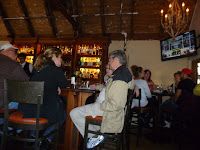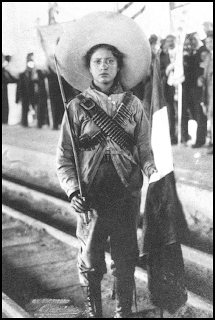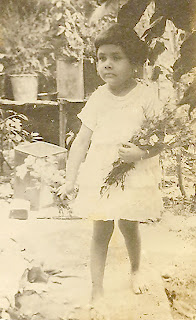 |
| Pacific Grove in the afternoon. |
I've been meaning to post ever since we got back from Spain, but life and work intruded -- in a happy way. I'm working on a new story, to be included in an anthology coming out next year.
Though I've kept my nose to the grindstone, it's made my blogging lackadaisical. Then Thanksgiving came -- a wonderful communal gathering with my beloved god family -- and after that we went to Pacific Grove for the weekend. Pacific Grove, Monterrey, and Carmel have long had a shared place in our hearts. We come back when we can, like homing pigeons, to walk the beaches and visit the art galleries in Carmel.
We spent both mornings in Pacific Grove, driving, then walking along the sea wall, enjoying the slate-blue of the distant waters, the foamy white ruffles of incoming waves, the soft hush-sh-sh of waves rippling and splashing on rocks, the muffled roar of larger waves, and the kwee-dkwee-kwee of the seagulls that soared and swooped from rocks to shore and back again.
 |
| A distant boat on the endless waters. |
 |
| A lone seagull, taking it all in. |
 |
| Rocks that jut up like sculptures. |
 |
| And a rock littered with roosting gulls. |
That was the ocean view.
On land, the ice plant that makes a fuchsia-colored carpet across the sand in spring was bereft of flowers, but it glistened in green and red tones like stained glass.
 |
| A path of beauty. |
 |
| Fall colors like stained glass |
 |
| Someone staring out to sea. |
For years I've wanted to visit the Monarch Grove Sanctuary in Pacific Grove, an "overwintering" spot for monarch butterflies, November through February each year, free for viewing. This time we did. Look closely. Nature has truly devised a great safety system for these delicate creatures;
At first we thought they were only dried
 |
Hundreds of butterflies with folded wings, looking like
so many dried leaves in their wonderful camouflage. |
leaves hanging from trees--and not
pretty leaves, at that. And then a little
kid pointed them out to us! "They're
in camouflage," he said. (Smart kid!)
We looked again, and were amazed.
Hundreds upon hundreds of folded
wings. Camouflage indeed!
 |
| One butterfly opened its wings |
Both afternoons, we drove into Carmel to enjoy the many art galleries. We have certain galleries we particularly like: One is
Classic Art Gallery. One is the Carmel Art Association, a collaborative gallery that features work by local artists and puts out a lovely small catalogue each year that is like a book of art gems. You can visit them
HERE. We also like
Jones & Terwilliger Galleries. But actually there are so many good galleries, an amble through them is like an amble through several fine art museums.
Because Rajan is into black and white photography, we stopped by two photography galleries we've always enjoyed.
One is the
Weston Gallery. They are featuring a color show in one section at present, but they specialize in the art of some of my husband's favorite black and white photographers: Ansel Adams (his hero), Edward and Brett Weston, Yousuf Karsh, Michael Kenna, Imogen Cunningham . . . . You can click on the name of the gallery above, and, once there, click on the artists and see wonderful samples of their work. The other is
Photography West Gallery, featuring some of the same artists, all working in black and white film (my husband's first love) rather than digital.
Both afternoons we stopped by a charming restaurant/bar called
Grasings on 6th and Mission, and had a glass of crisp Chardonnay. The place had a soft, warm atmosphere and a friendly staff, and it made for a nice pause in the day.
 |
| Hubby's ear in lower left corner. :-) |
 |
| A nice pause in the day. |
My birthday was Monday, but since we would be driving back to Sacramento that day, we celebrated Sunday evening at a little French restaurant in Pacific Grove. (Or maybe it's Monterrey: those areas run into each other, and I'm never quite sure. )
It's called
Fifi's Bistro Cafe , reasonably price,
a charming restaurant with a cosy atmosphere. Fifi was there that evening, as it was the restaurant's 30th anniversary. She's French, of course, and she looked casually
chic, as the French somehow always manage to do -- black dress, red scarf, hair tumbled back in a clip. We are not dessert eaters, but when she found out we were celebrating my birthday, she insisted on bring an order of
flan for us to share, and she brought a beautiful red rose to the table, scattering the petals over the white tablecloth. How French!
I have a lot of questions in this post: Have you ever seen the monarch butterflies wintering over in some location? (I understand there are quite a few; not just Pacific Grove.) Do you have a special affinity for the ocean? Do you enjoy black and white photography? What is your favorite art form?

Hola, les paso esta info del taller que va a impertir Oscar Carreño eb Monterrey
sobre cuento infantil.
TALLER DE CUENTO INFANTIL
Inicia:
8 de Agosto 2009
Abarcará:
•Teoria de creatividad, cómo sacar ideas.
•Diferentes tipos de libros infantiles.
•Comparaciones con ejemplos.
•Trucos de dibujo y diseño de personajes.
•Ilustración: composición y color.
•Armado de dommy y presentación.
Objetivo:
Poder presentar un proyecto infantil a una editorial
y/o entrar al concurso del Fondo de Cultura Económica "A la Orilla del Viento"
Informes:
m o n e r o m a n [@] h o t m a i l . c o m


Unknown Soldaderas - Mexican Revolution
Porfirio Dias was Mexico’s president for 30 years following centuries of occupation, colonization, uprisings, invasions by Spain and France, and war with the United States. Dias’ autocratic regime gave rise to a new, industrialized Mexico, made possible by exploiting the majority of the people, stripping them of human rights while Dias built political power and personal wealth. Those who suffered most were the poor, the laborers, indios and women. In 1895, civil code was passed which severely restricted Mexican women to a life of serving their husbands, their families, and the Catholic Church.
The country was divided on these and other issues and Mexico fell into a ten-year period of chaos, with back-to-back political coups and foreign intervention. But, through the shifts in power, peasants gathered together to create a land that could serve all of Mexico’s people, including her women.This presented a conflict between traditional women who enjoyed their more domestic, subservient roles and an emerging feminism completely unknown in Mexico before. It became one of the underlying principles of the Mexican Revolution and the subject of one of the great reforms to arise from this period.
The women who stood up for higher ideals and demanded change were extraordinary, particularly given their social position and their time in history. They joined the Revolution, demanding reform across a country in disarray. Some became political voices, journalists who wrote articles opposing the tyranny of the ruling class. Some became nurses treating wounded revolutionary soldiers. Others served as spies or procured provisions for the small bands of peasants who continued fighting for freedom from 1910 until well after 1920. A few picked up weapons and joined forces, with Zapata in the south or Villa in the north, to fight along side the men. They became known as las soldaderas.
My mother, now in her late eighties, recalled the stories from her childhood in Mexico of a mysterious woman her Mama hated, a woman who came to their house to see the son she had left behind. Her name was Soledad.
For years, Soledad was described by my grandmother as a reckless harlot who irresponsibly left her child in the care of others so she could follow the revolutionary soldiers. To my grandmother, who could only view the events through the lens of her traditional upbringing, it was disgraceful. And, for more than a lifetime, only one side of the story was told. Finally, decades later, when my mother researched Mexican history, another story, long forgotten, materialized. This is my mother, Gloria's, recollection.
~~~~~~~~~~~~~
I was born in 1921 but I can remember from about the age of 4, our life in Mexico. Papa’s name was Juan. He was born in Linares, Mexico, located about 130 km from Monterrey City in the State of Nuevo Leon.
 Juan
JuanHe was orphaned in early childhood and sent to the seminary where he got an education. He was a newspaper reporter, book binder and writer. He was also an amateur ‘novillero,’ a novice bullfighter who fights young bulls. He had a younger sister, Soledad.
My parents settled in Monterrey once they were married. Mama was quite young, about 13. In the early years of the marriage, Mama – still a child herself, loved dressing up in beautiful clothes - taffeta dresses in popular styles of the time, fur coats and gold jewelry. She wore them on Sunday outings. Papa was very active in social clubs, sports and celebrations around town. Mama, beautiful and proud, saw her life as sophisticated and special, the life she was born to live.
We had 2 maids- one to care for us children, the other to cook and clean. Our house was always spotless and it seemed very grand. There was a pond with fine little pebbles inside the house, and here I could play for hours as a child. In the back yard was a beautiful garden. We seldom interacted with Mama but rather with my Nana, because proper women of class did not bother with domestic chores. When I was bathed by my Nana, dried with clean sheets, dressed in a hand- embroidered slip, I felt like a princess.
 Gloria, age 4
Gloria, age 4
The few memories of going out with Mama were of going to the tailor for new clothes of fine materials, fur trim, and adornments. Mama always wore jewels and lace and very delicate clothing. We children always had to be dressed up as well. We were like her little dolls.
The biggest problem in Mama’s life was her sister-in-law, Soledad. At the age of about 17, Soledad had become a ‘Villista,’ one of the volunteers supporting Pancho Villa in the Revolution. This was a great embarrassment to Mama. To make matters worse, Soledad fell in love with a French soldier and bore their son, Alfonso. But, instead of coming home and managing her responsibilities, Soledad continued fighting the war. Alfonso lived with us.
Between battles, Soledad nursed the wounded or went begging for food and supplies, not seeing her son for months. They say that that she would sneak to our house at night, all filthy and hungry, and want to see Alfonso. She didn’t bring money or food, and even asked for provisions to take back with her. Mama hated her for this.
Mama was not political. She enjoyed her role, surrounded by domestic affluence and security. What did she care about women’s rights? To Mama, Soledad’s uncivilized behavior represented everything coarse and disgusting in a woman. She was deeply offended by the excitement that Soledad caused when she came to the house. Finally, sick from an epidemic and malnutrition and exhaustion, Soledad’s tiny body gave out. She died and, much to Mama’s anger, her son Alfonso became Mama’s irrevocable responsibility.
Mama did not see her sister-in-law as heroic, although Soledad had fought for ten years in the harsh terrain of Mexico, ill equipped and out manned, unpaid and driven only by the shredded dream of freedom. Mama only saw the additional burden of the child she would now have to raise with her own.
Daily, Mama expressed her frustration to Alfonso, berating his mother and her foolish choices. She called his mother a whore who lived like a gypsy, bedding any soldier who would tell her she was pretty. He was lucky, Mama would say, that his mother had died. Her jealousy of the romantic and heroic woman masked for all of Alfonso’s life the courage and spirit of the mother he never knew.
A few years later, one of Papa’s cousins, who already lived and worked in the US, insisted that we come right away to take part in the opportunities and wealth just north of the border. With the pressure of our growing family, including Alfonso, it seemed the right thing to do. So, Papa took Alfonso and came to Texas first to see if it was as fantastic as it was described. And it was, in every way. Six months later, Papa came for us.
As if on a splendid adventure, we crossed the border, dressed in all our finery. It was Washington’s Birthday, February 22, 1926. I remember entering the city of Laredo, Texas like I was walking in a dream. There were fireworks everywhere and flags and people celebrating in the streets, so beautiful and exciting. I was nearly five years old.
The family settled in San Antonio where Papa was working as a newspaper reporter and started a printing and bookbinding business. And, even after a problem with our documents caused us to be temporarily repatriated, we finally established roots in South Texas and Mama believed that her life of luxury was about to become even better. And it did . . . for almost three years.
Then, the Depression came and everything crashed overnight. The stock market and jobs, businesses - everything just crumbled. There was no time to plan or adjust- it seemed like the prosperous life everyone was enjoying burst like a water pipe and everyone’s dreams just gushed out into the street.
After that, things became very difficult for Mexican people. With no jobs for the men and many mouths to feed, my Mama was forced to work beneath her class in order to survive. She learned to raise chickens so the family could eat. She made liquor to sell during prohibition. She cooked for the parish priest or made garments for women who could afford new clothes. She became a maid, cleaning Anglo women’s homes. She gave birth to 13 children but only six survived. Through it all, Mama maintained an air of the life she once had, the elegance she still dreamed of.
Many years later, I found some research on the soldaderas. I started collecting it for Alfonso because I wanted him to know that he should be proud of his mother. I wanted to tell him that Soledad was fighting against discrimination and injustice. The soldaderas had helped the revolution stay alive. They were heroes. But he died before I could talk to him about it. I don’t think he ever knew.
Alfonso 1950 My mother, Gloria 1940


My mother went on to earn a college education, in spite of her Mama’s objection. She taught school for 33 years in Texas and taught her three daughters to be independent thinkers, self- sufficient and proud of our Mexican heritage. In only two generations, women of our family were transformed from both traditionalist women of leisure and zealous freedom fighters into penniless immigrants, and finally, into progressive American women of conviction and purpose.
I dream that there’s a little of Soledad in each of us. Whether she was a silly girl following the camps or a woman of grit who heard freedom’s call to arms, we will never know. I prefer to think that she was a little of both . . . dutiful to her cause and yet romantically in love with the idea that she would spill her blood to wash away injustice.1915 My Grandparents 1960

 About The Author...
About The Author... Annette Leal MatternDuring her long career in technology, Annette held numerous corporate leadership positions with Fortune 100 companies where she championed development of minorities for upper management. She received the National Women of Color Technology Award for Enlightenment for her diversity achievements and was recognized by Latina Style and Vice President Gore as one of the most influential Latinas in American business. In 2000, she left her corporate work to devote herself to women's cancer causes. She published her first book, Outside The Lines of love, life, and cancer, to help others cope with the disease. She has also been published in Hispanic Engineer and several other media. Annette serves on the board of directors of the Ovarian Cancer National Alliance and founded the Ovarian Cancer Alliance of Arizona, for which she serves as president. Annette also writes for http://www.empowher.com/. She and her husband, Rich, live in Scottsdale AZ.
Annette Leal MatternDuring her long career in technology, Annette held numerous corporate leadership positions with Fortune 100 companies where she championed development of minorities for upper management. She received the National Women of Color Technology Award for Enlightenment for her diversity achievements and was recognized by Latina Style and Vice President Gore as one of the most influential Latinas in American business. In 2000, she left her corporate work to devote herself to women's cancer causes. She published her first book, Outside The Lines of love, life, and cancer, to help others cope with the disease. She has also been published in Hispanic Engineer and several other media. Annette serves on the board of directors of the Ovarian Cancer National Alliance and founded the Ovarian Cancer Alliance of Arizona, for which she serves as president. Annette also writes for http://www.empowher.com/. She and her husband, Rich, live in Scottsdale AZ.

























Thank you for such a wonderful piece of family and Mexican history. I suggest that you share the link with Somos Primos at:
http://www.somosprimos.com/
These stories are so important for our people and others.
How family stories echo in literature. Elena Poniatowska has a soldadera whose story could mirror incidents in granma's and mama's history.
http://books.google.com/books?id=xGAGAAAACAAJ&dq=inauthor:%22+Elena+Poniatowska%22
Nice post - thanks for sharing your family stories. They are very similar to stories my mother still tells, and to the stories my grandmother used to tell.
Hola Annette,
Welcome to La Bloga. Thank you for your great family story.
saludos,
Rene
What a beautiful story. Although Alfonso wasn't able to read it, we have and therefore Soledad's story will live.
Thank you so much for sharing Soledad's life (and yours!) with us.
Thanks for such a warm welcome to La Bloga. I'm honored to add a small voice to the intelligent conversation of this site.
What an extraordinary story! Thank you for sharing this.